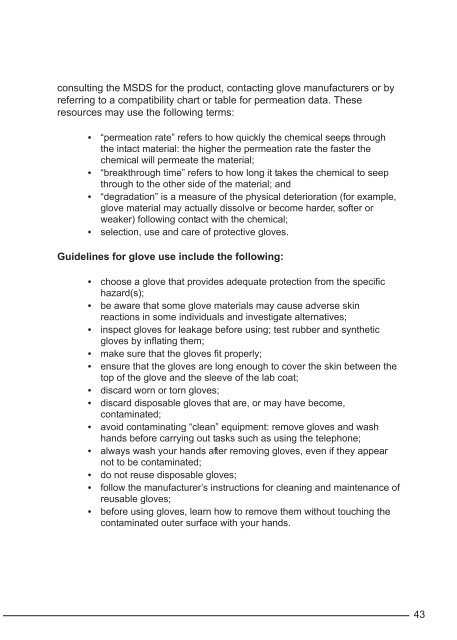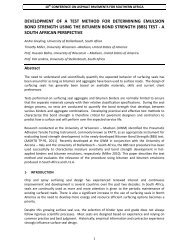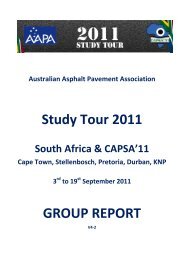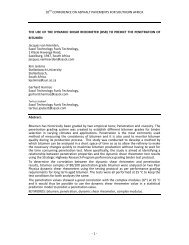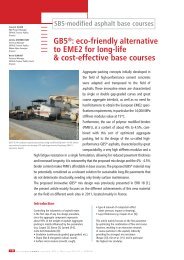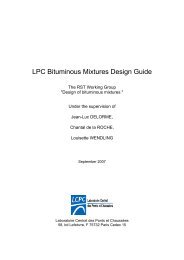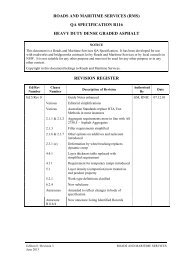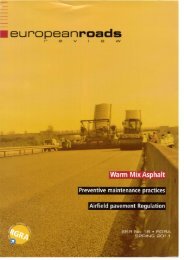Guide to the safe handling of solvents in a bituminous ... - Aapaq.org
Guide to the safe handling of solvents in a bituminous ... - Aapaq.org
Guide to the safe handling of solvents in a bituminous ... - Aapaq.org
- No tags were found...
Create successful ePaper yourself
Turn your PDF publications into a flip-book with our unique Google optimized e-Paper software.
consult<strong>in</strong>g <strong>the</strong> MSDS for <strong>the</strong> product, contact<strong>in</strong>g glove manufacturers or byreferr<strong>in</strong>g <strong>to</strong> a compatibility chart or table for permeation data. Theseresources may use <strong>the</strong> follow<strong>in</strong>g terms:• “permeation rate” refers <strong>to</strong> how quickly <strong>the</strong> chemical seeps through<strong>the</strong> <strong>in</strong>tact material: <strong>the</strong> higher <strong>the</strong> permeation rate <strong>the</strong> faster <strong>the</strong>chemical will permeate <strong>the</strong> material;• “breakthrough time” refers <strong>to</strong> how long it takes <strong>the</strong> chemical <strong>to</strong> seepthrough <strong>to</strong> <strong>the</strong> o<strong>the</strong>r side <strong>of</strong> <strong>the</strong> material; and• “degradation” is a measure <strong>of</strong> <strong>the</strong> physical deterioration (for example,glove material may actually dissolve or become harder, s<strong>of</strong>ter orweaker) follow<strong>in</strong>g contact with <strong>the</strong> chemical;• selection, use and care <strong>of</strong> protective gloves.<strong>Guide</strong>l<strong>in</strong>es for glove use <strong>in</strong>clude <strong>the</strong> follow<strong>in</strong>g:• choose a glove that provides adequate protection from <strong>the</strong> specifichazard(s);• be aware that some glove materials may cause adverse sk<strong>in</strong>reactions <strong>in</strong> some <strong>in</strong>dividuals and <strong>in</strong>vestigate alternatives;• <strong>in</strong>spect gloves for leakage before us<strong>in</strong>g; test rubber and syn<strong>the</strong>ticgloves by <strong>in</strong>flat<strong>in</strong>g <strong>the</strong>m;• make sure that <strong>the</strong> gloves fit properly;• ensure that <strong>the</strong> gloves are long enough <strong>to</strong> cover <strong>the</strong> sk<strong>in</strong> between <strong>the</strong><strong>to</strong>p <strong>of</strong> <strong>the</strong> glove and <strong>the</strong> sleeve <strong>of</strong> <strong>the</strong> lab coat;• discard worn or <strong>to</strong>rn gloves;• discard disposable gloves that are, or may have become,contam<strong>in</strong>ated;• avoid contam<strong>in</strong>at<strong>in</strong>g “clean” equipment: remove gloves and washhands before carry<strong>in</strong>g out tasks such as us<strong>in</strong>g <strong>the</strong> telephone;• always wash your hands after remov<strong>in</strong>g gloves, even if <strong>the</strong>y appearnot <strong>to</strong> be contam<strong>in</strong>ated;• do not reuse disposable gloves;• follow <strong>the</strong> manufacturer’s <strong>in</strong>structions for clean<strong>in</strong>g and ma<strong>in</strong>tenance <strong>of</strong>reusable gloves;• before us<strong>in</strong>g gloves, learn how <strong>to</strong> remove <strong>the</strong>m without <strong>to</strong>uch<strong>in</strong>g <strong>the</strong>contam<strong>in</strong>ated outer surface with your hands.43


